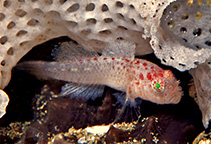| Diagnosis: |
Dorsal spines (total): -7; Dorsal soft rays (total): 8-9; Anal spines: -1; Anal soft rays: 7-8; Vertebrae: -26. Diagnosis: 2nd dorsal-fin rays I,8 or 9; anal-fin rays I,7 or 8; pectoral-fin rays 16, all rays unbranched; segmented pelvic-fin rays unbranched, except 5th ray with single branching, all pelvic-fin rays connected by a well-developed membrane, extending nearly to tip of each ray, forming disk, pelvic frenum absent; sensory pores on dorsal surface of head reduced, only a single pair of mid-interorbital pores; other cephalic sensory pores include supraotic (1), anterior otic (1), and preopercular (2); missing head pores include nasal, anterior interorbital, and intertemporal; anterior nares forming enlarged tube, its length about half pupil diameter; color in life whitish to light pink with scattered red spots (Ref. 107790).
Description: dorsal-fin elements VI+I,8-9; 1st dorsal fin gently rounded without filamentous spines, 2nd and 3rd spines longest; anal-fin elements I,7-8; pectoral-fin rays 16, all rays unbranched; pelvic-fin rays I,5, 1st to 4th segmented rays unbranched, 5th ray with single branching about half-way along its length, 4th and 5th rays longest, pelvic-fin membranes between the rays well-developed, forming disk, pelvic frenum absent; caudal fin with 12 branched and 17 segmented rays and 5–6 unsegmented (procurrent) rays dorsally and ventrally; transverse scale rows 7; scales finely ctenoid on body, no cycloid scales present; head, belly and breast region without scales; anterior extent of scales level with a line between upper margin of pectoral fin and about origin of 2nd dorsal fin, except narrow naked area also present immediately below base of 2nd dorsal fin; front of head sloping with an angle of about 55° from horizontal axis; mouth terminal, inclined obliquely upwards, forming an angle of about 65° to horizontal axis of body, lower jaw not projecting; maxilla extending posteriorly to about anterior edge of pupil; dentition as illustrated for genus by Winterbottom & Hoese (1988), consisting of about 3 irregular rows of short conical teeth in each jaw, with 3–5 enlarged, curved, spaced canines in outer row near symphysis of upper jaw; lower jaw with single enlarged canine in innermost row near symphysis; both nostrils with enlarged opening, anterior nares forming tube, its length about half pupil diameter, posterior nares with elevated rim; gill opening extending forward to below posteroventral edge of preoperculum; cephalic sensory pores include paired interorbital pores, supraotic pore, anterior otic pore, and paired preopercular pores; urogenital papilla in female smooth, bulbous, with pair of finger-like projections laterally on each side; that of male smooth and elongate (reaching base of anal-fin spine), with weakly fimbriate margin; origin of 1st dorsal fin slightly behind posterior margin of pectoral-fin base; origin of 2nd dorsal fin about level with anal-fin origin (Ref. 107790).
Color in life: generally pale pink to whitish, semi-translucent on posteriormost portion of body, including caudal peduncle; widely scattered red spots on dorsal surface of head, nape, upper operculum, and along base of dorsal fin, generally smaller posteriorly; interrupted, diffuse, internal white stripe following vertebral column sometimes evident; fins semi-translucent white; head, body, and fins densely covered with fine, bright white speckling; pupil green when illuminated with strobe light (Ref. 107790). Color in alcohol: uniformly whitish to slightly pale yellowish with no hint of red spots as seen in life (Ref. 107790). |
